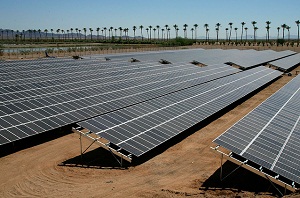FERC proposes SEIA-backed solar interconnection rule
 Almost a year ago the Solar Energy Industries Association (SEIA) petitioned the Federal Energy Regulatory Commission (FERC) to fast track the interconnection process for certain solar installations. Basically, if FERC adopts and finalizes the rule, it could speed the process of hooking more solar up to the—and drop the costs of doing so, making solar cheaper without using incentives or other mechanisms to do so.
Almost a year ago the Solar Energy Industries Association (SEIA) petitioned the Federal Energy Regulatory Commission (FERC) to fast track the interconnection process for certain solar installations. Basically, if FERC adopts and finalizes the rule, it could speed the process of hooking more solar up to the—and drop the costs of doing so, making solar cheaper without using incentives or other mechanisms to do so.
If adopted, the rule could double the amount of solar considered under the fast-track process, according to SEIA. It would eliminate the need for certain costly and time-consuming studies and allow solar projects that meet certain technical requirements to be fast tracked through the interconnection process. As a result, the amount of solar considered under the “fast track” processes is expected to as much as double.
“We applaud FERC for recognizing the challenges facing wholesale distributed generation development, which is one of the fastest-growing segments of the solar energy industry. This important proposed rule has the potential to roughly double the amount of solar generation capacity eligible to be fast-tracked in the U.S.,” said SEIA CEO Rhone Resch. “SEIA also urges the states to consider using FERC’s proposed updated rule as a model and starting point for updating their own interconnection rules.”
SEIA filed the interconnection rulemaking petition with FERC in February 2012 to update the national interconnection procedures for projects up to 20 megawatts. The rule would update FERC Order No. 2006, established in 2005. The rule established national interconnection procedures for such projects for the first time. SEIA called the order groundbreaking for the industry. “The procedures were voluntarily adopted by many states to apply to the retail interconnection process. However, demand for solar energy has grown dramatically since Order No. 2006 was issued more than seven years ago, and certain aspects of the order have become unnecessary barriers to cost-effective and timely interconnections,” the advocacy organization said.
The rule would make four reforms, allow interconnection customers to request a pre-application report to evaluate potential points of interconnection, revise the current 2 megawatt threshold for participation in the fast track process up to 5 megawatts, revise options for projects that fail the Fast Track screens, and revise the Small Generator Interconnection Procedures study agreement by allowing potential interconnection customers to provide written comments on necessary upgrades, according to FERC.



